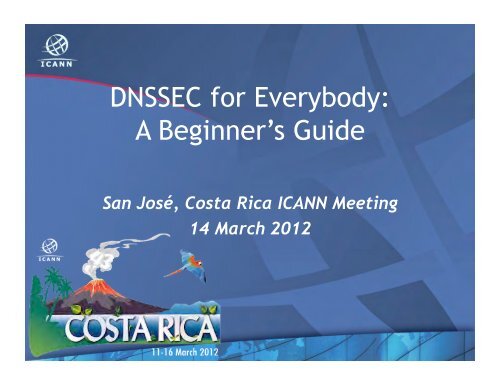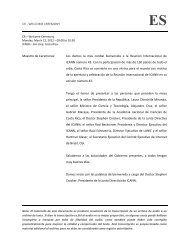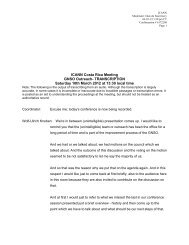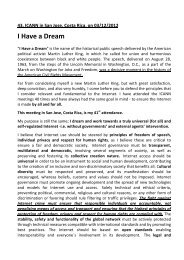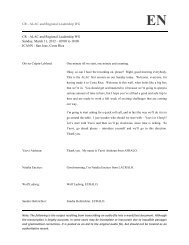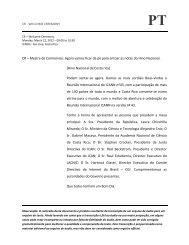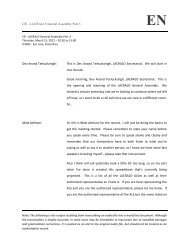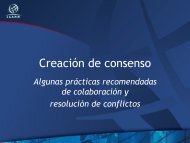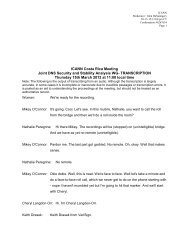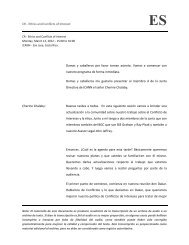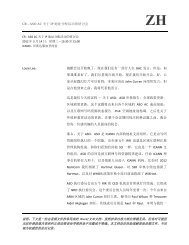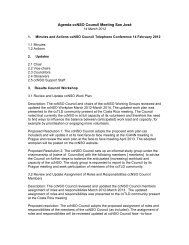DNSSEC for Everybody: A Beginner's Guide - Costa Rica - icann
DNSSEC for Everybody: A Beginner's Guide - Costa Rica - icann
DNSSEC for Everybody: A Beginner's Guide - Costa Rica - icann
Create successful ePaper yourself
Turn your PDF publications into a flip-book with our unique Google optimized e-Paper software.
<strong>DNSSEC</strong> <strong>for</strong> <strong>Everybody</strong>:<br />
A Beginner’s <strong>Guide</strong><br />
San José, <strong>Costa</strong> <strong>Rica</strong> ICANN Meeting<br />
14 March 2012
The Schedule<br />
2
This is Ugwina. She lives in a cave on the edge of the Grand Canyon...
This is Og. He lives in a cave on the other side of the Grand Canyon...
It’s a long way down and a long way round. Ugwina and Og don’t get to<br />
talk much...
On one of their rare visits, they notice the smoke coming from Og’s fire
...and soon they are chatting regularly using smoke signals
So Ugwina sets off down the canyon to try and sort out the mess...
until one day, mischievous caveman Kaminsky moves in next door to Ug and<br />
starts sending smoke signals too...
Now Ugwina is really confused. She doesn’t know which smoke to<br />
believe...
Ugwina and Og consult the wise village elders. Caveman Diffie thinks<br />
that he might have a cunning idea...
And in a flash, jumps up and runs into Ug’s cave...!
Right at the back, he finds a pile of strangely coloured sand<br />
that has only ever been found in Ug’s cave...
And with a skip, he rushes out and throws some of the sand onto the<br />
fire. The smoke turns a magnificent blue...
Now Ugwina and Og can chat happily again, safe in the knowledge that<br />
nobody can interfere with their conversation…
Introduction to <strong>DNSSEC</strong><br />
Roy Arends, Nominet UK
High-Level Concept of DNS<br />
… uk <br />
co.uk <br />
root <br />
com <br />
bigbank.com <br />
cr <br />
nic.cr <br />
…
High-Level Concept of DNS<br />
• A resolver knows where the root‐zone is <br />
• Traverses the DNS hierarchy <br />
• Each level refers the resolver to the next level <br />
• UnCl the quesCon has been answered <br />
• The resolver caches all that in<strong>for</strong>maCon <strong>for</strong> <br />
future use.
…Ugwina, the resolver, chatting with Og, the server…
High-Level Concept of DNS<br />
root <br />
uk com <br />
bigbank.com <br />
(www) <br />
cr
High-Level Concept of DNS<br />
• There is no security <br />
• Names are easily spoofed <br />
• Caches are easily poisoned
…Ugwina, the resolver is confused. She doesn’t know who the real Og is…
High-Level Concept of DNS<br />
root <br />
uk com <br />
bigbank.com <br />
(www) <br />
bigbank.com <br />
(www) <br />
cr
<strong>DNSSEC</strong> is the Solution<br />
• <strong>DNSSEC</strong> uses digital signatures to assure that <br />
in<strong>for</strong>maCon is correct and came from the right <br />
place. <br />
• The keys and signatures to verify the <br />
in<strong>for</strong>maCon, is stored in the DNS as well <br />
• Since DNS is a lookup system, keys can simply <br />
be looked up, like any data.
…Ugwina, the resolver, can verify that the real Og sends the message…
High-Level Concept of <strong>DNSSEC</strong><br />
• A resolver knows what the root‐key is <br />
• It builds a Chain of Trust: <br />
– Each level signs the key of the next level <br />
– UnCl the chain is complete
High-Level Concept of <strong>DNSSEC</strong><br />
✔ root <br />
uk ✔ com <br />
✔<br />
bigbank.com <br />
(www) <br />
✗<br />
bigbank.com <br />
(www) <br />
cr
A Sample <strong>DNSSEC</strong><br />
Implementation &<br />
<strong>Guide</strong> to Deployment<br />
Options<br />
Russ Mundy, Cobham
<strong>DNSSEC</strong> Implementation<br />
Samples<br />
• <strong>DNSSEC</strong> implementation depends upon & is<br />
mostly driven by an activity’s DNS<br />
functions<br />
– DNS is made up of many parts, e.g., name<br />
server operators, applications users, name<br />
holders (“owners”), DNS provisioning<br />
– Activities with large, complex DNS functions<br />
are more likely to have more complex <strong>DNSSEC</strong><br />
implementation activities<br />
• Also more likely to have ‘DNS knowledgeable’ staff
<strong>DNSSEC</strong> Implementation<br />
Samples, Continued<br />
• DNS size and complexity examples:<br />
– Registry responsible <strong>for</strong> a large TLD operation,<br />
e.g., .com<br />
– Substantial enterprise with many components<br />
with many geographic locations, e.g., hp.com<br />
– Internet-based businesses with a number of<br />
business critical zones, e.g., www.verisign.com<br />
– Activities with non-critical DNS zones, e.g., netsnmp.org<br />
– Proverbial Internet end users (all of us here)
Zones<br />
" "<br />
cc tv com net org name info<br />
verisign cnn hp<br />
www<br />
www money<br />
www corp hpl<br />
holmes winnie www
General Principle:<br />
• If an activity does a lot with their DNS<br />
functions and operations then they<br />
probably will want to do a lot with the<br />
associated <strong>DNSSEC</strong> pieces;<br />
• If an activity does little or nothing with<br />
their DNS functions and operations then<br />
they probably will want to do little or<br />
nothing with the associated <strong>DNSSEC</strong><br />
pieces.
DNS Zone Content Flow<br />
(<strong>for</strong> example, www.<strong>icann</strong>.org or www.cnn.com)<br />
Registrants <br />
Registrars <br />
Registries <br />
Zone Name Servers <br />
Provisioning Area Publica9on Area <br />
Content Starts <br />
Here <br />
Content <br />
Input <br />
russ.mundy@cobham.com<br />
DNS <br />
‘Content Picture’ <br />
DNS Resolvers <br />
34<br />
Content <br />
Output <br />
Content Used <br />
Here <br />
User Applica9ons
I need to<br />
have a<br />
WWW<br />
record<br />
Zone<br />
Add<br />
Data<br />
publish<br />
russ.mundy@cobham.com<br />
Simple Illustration<br />
of DNS Components<br />
Authoritative<br />
Server<br />
3. www is 1.2.3.4<br />
Recursive<br />
Server<br />
2. Request www<br />
1. Request www<br />
4. www is 1.2.3.4<br />
35<br />
End<br />
User<br />
Client
Name Resolution<br />
Root Name Servers <br />
root‐servers.net <br />
a b c d e f g h i j k l m<br />
.com/.net Name Servers <br />
gtld‐servers.net <br />
a b c d e f g h i j k l m<br />
cnn.com Name Servers <br />
cnn.com <br />
n<br />
s<br />
1<br />
n<br />
s<br />
2<br />
n<br />
s<br />
3<br />
n<br />
s<br />
4<br />
cnn.com Web Site <br />
www.cnn.com <br />
www.cnn.com IP<br />
.com name servers<br />
www.cnn.com IP?<br />
www.cnn.com IP?<br />
cnn.com<br />
name servers<br />
www.cnn.com IP?<br />
HTTP request<br />
HTTP response<br />
Recursive <br />
Name Server <br />
www.cnn.com IP<br />
www.cnn.com IP<br />
Internet <br />
User
1 Webpage = Multiple DNS Name Resolutions<br />
russ.mundy@sparta.com<br />
37
www.cnn.com
DNS Basic Functions<br />
• DNS provides the translation from names<br />
to network addresses<br />
• Get the right DNS content to Internet<br />
users<br />
IT’S DNS ZONE DATA THAT<br />
MATTERS!<br />
russ.mundy@cobham.com<br />
39
How Does <strong>DNSSEC</strong> Fit?<br />
• <strong>DNSSEC</strong> required to thwart attacks on DNS<br />
CONTENT<br />
– DNS attacks used to attack Internet users<br />
applications<br />
Protect DNS ZONE DATA as much<br />
as (or more than) any <strong>DNSSEC</strong> in<strong>for</strong>mation<br />
Including <strong>DNSSEC</strong> private keys!!<br />
russ.mundy@cobham.com<br />
40
DNS Zone Content Flow<br />
(<strong>for</strong> example, www.<strong>icann</strong>.org or www.cnn.com)<br />
Registrants <br />
Registrars <br />
Registries <br />
Zone Name Servers <br />
Provisioning Area Publica9on Area <br />
Content Starts <br />
Here <br />
Content <br />
Input <br />
russ.mundy@cobham.com<br />
DNS <br />
‘Content Picture’ <br />
<strong>DNSSEC</strong> specs HERE <br />
DNS Resolvers <br />
41<br />
Content <br />
Output <br />
Content Used <br />
Here <br />
User Applica9ons
I need to<br />
have a<br />
signed<br />
WWW<br />
record<br />
Simple Addition<br />
of <strong>DNSSEC</strong><br />
(there are both much more and less complex setups than this)<br />
Zone<br />
Signed<br />
Add<br />
Data<br />
sign<br />
Data<br />
publish<br />
new<br />
russ.mundy@sparta.com<br />
Authoritative<br />
Server<br />
3. www is 1.2.3.4<br />
Validating<br />
Recursive<br />
Server<br />
2. Request www<br />
1. Request www<br />
4. www is 1.2.3.4<br />
42<br />
End<br />
User<br />
Client
Implementation Samples<br />
• In general, try to do <strong>DNSSEC</strong> in the same<br />
way that you are doing DNS
Implementation Samples<br />
• If you’re running much or all of your DNS<br />
functions and operations, <strong>DNSSEC</strong><br />
implementation could be based on:<br />
– Extend DNS operation to incorporate <strong>DNSSEC</strong>;<br />
– Use open source <strong>DNSSEC</strong> tools (e.g., from<br />
www.dnssec-tools.org or opendnssec.org);<br />
– Use commercial <strong>DNSSEC</strong> products;<br />
– Mix elements from ‘all of the above’
Implementation Samples<br />
• If DNS functions and operations are being<br />
done with one (or several) software &<br />
hardware products, find out if the product<br />
providers have (or will) incorporate <strong>DNSSEC</strong><br />
to support your DNS functions and<br />
operations.<br />
– If not, push them <strong>for</strong> adding <strong>DNSSEC</strong> to their<br />
products; or<br />
– Examine additional or different products or<br />
services that will provide <strong>DNSSEC</strong>, e.g.,<br />
emerging <strong>DNSSEC</strong> signing services.
Implementation Samples<br />
• If you are the holder (‘owner’) of names but<br />
“out-source” DNS functions and operations,<br />
e.g., to your registrar, then determine if the<br />
“out-source” offers <strong>DNSSEC</strong> capability.<br />
– If not, push on them to develop and offer<br />
<strong>DNSSEC</strong> capability<br />
– Consider using a different “out-source” DNS<br />
service<br />
– Consider developing “in-house” DNS (and<br />
<strong>DNSSEC</strong>) capabilities
Thank You and Questions


